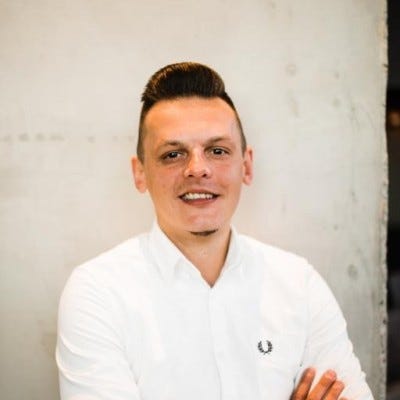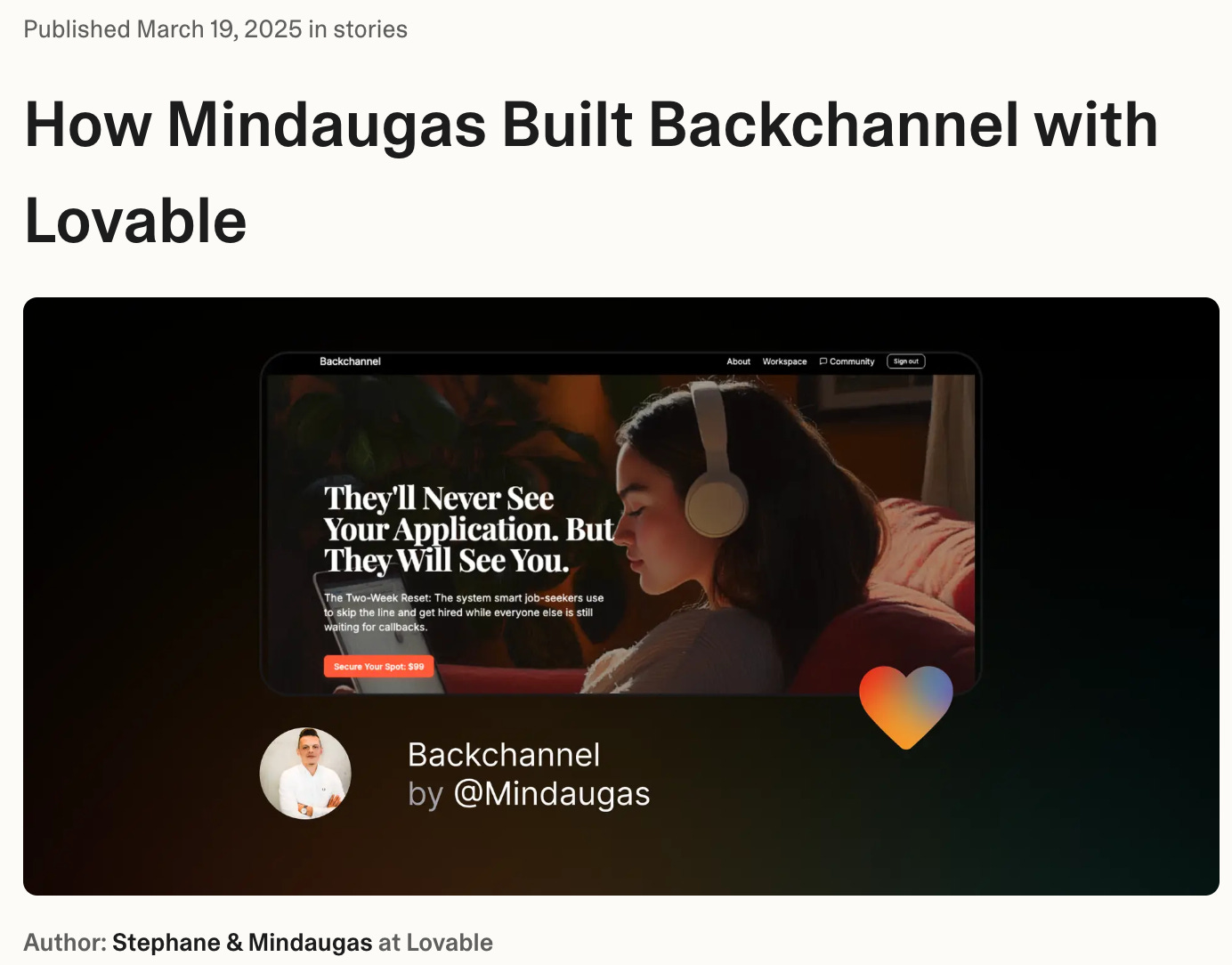How to get headhunted by Lovable ❤️
A few months ago, Mindaugas Petrutis was rejected by his dream company, Lovable. Three weeks ago, they headhunted him for his dream role. His story is a masterclass in how to get hired in 2025.
Job hunting is painful.
We’ve all seen the heartbreaking stories on LinkedIn: “It’s been six months, and I haven’t found anything,” “I’m stuck and don’t know what to do next,” etc.
In 2025, getting hired through a traditional application is nothing short of a miracle. But for those creative enough to try, there is another way…
Mindaugas Petrutis’ story is fascinating. His hustle is something that is both rare and contagious, a few highlights below:
He got into recruitment with no experience: Sales experience was a must, so he took what he describes as “the lowest level sales job he could find”.
He broke into recruitment and found an edge: In-person communities. He’d organise drinks, invite people to events and build deep relationships.
His love for communities led him to InVision. A single email to the CEO, whom he knew from his community work, resulted in interviews and a job offer.
He built a product with Lovable that ultimately led to a job: The Backchannel was a side-project that got him noticed and eventually hired by Lovable.
He is living proof of the famous quote:
“You can just do things”.
In this week’s edition, we discuss:
How he was hired at Invision and Lovable
The opportunity he sees with “building in public”
Building Backchannel to help people get hired
How he was hired at Invision and Lovable
His approach is pretty simple: he plays the long game.
I want you to picture 2 scenarios:
Someone randomly messages you on LinkedIn. This is the first time you’re seeing their name. They’re asking for help getting hired at your current company.
Someone whose events you’ve attended, who you’ve spoken to several times and who you trust sends a message asking for the same thing.
This example might sound overly simplistic, but #1 is literally what I get contacted on LinkedIn for at least five times per week. #2 is rare, but when it does happen, you certainly want to help. Occasionally, it might even lead to a great hire.
It’s precisely the approach Mindaugas took to getting hired at InVision:
“
I’d met the CEO and one of the VPs several times, I’d co-hosted an event with Invision for my own startup. When I decided I wanted to get hired, I sent a short email saying “I’ve met a bunch of your team and everyone I speak to is amazing, helpful and talented. I’m looking for my next opportunity and InVision is a company I deeply admire”.
As luck would have it, InVision were building a team in Europe at that very moment. The CEO introduced him to the hiring manager. Long story short: he got a job offer.
You might be thinking, “Meh, got lucky”. You’d think that until you hear how he was hired at Lovable.
“
I was obsessed with Lovable. I built my own personal projects and shared them with the team, with product feedback. One of my projects, Backchannel (a product built to help job seekers get hired) got enough traction that the team asked if they could feature it on their blog. I was basically a superuser. I was even attending their events as a guest.
The next time an opportunity on Lovable’s growth team came up, guess who they called?
“
People at Lovable were viewing my LinkedIn profile, including the founder Anton. I got a message from Elena Verna (LinkedIn and Substack guru!) who leads growth, asking to chat. After a couple of calls and working sessions, I’d landed a job.
This is how you stand out. Submitting a generic application will only take you so far; ironically, Mindaugas had submitted one before and never heard back. This level of obsession is what gets you noticed and ultimately hired.
The opportunity he sees with “building in public”
Mindaugas created a win-win situation for himself. Yes, he was sending Lovable signals, and power users are always at the front of the line for job applications, but the alternative was that he was building in public.
“
I was literally working on random ideas and projects. And then I’d share them on LinkedIn. I would quickly prototype a product, post about it and see whether it generated any interest. The number of interesting people who reached out wanting to talk (both old and new acquaintances ) asking whether I wanted to partner, start something together or join an existing venture was amazing.
It's incredible to think that his “random ideas and projects” led to a job at one of the hottest companies in the world today. If you’re reading this and wondering how to increase your chances of finding a job, remember: “you can just do stuff.”
Many people cringe at the thought of posting on LinkedIn, writing on Substack, sharing their projects, etc. Usually, those people are taking themselves too seriously. If putting your work out into the world results in someone appreciating it, then great. If not, they’ll ignore you, and nobody will remember anyway. Win-win!
Building Backchannel to help people get hired
With a background as a recruiter, Mindaugas would frequently be asked for help navigating the job hunt. This led him to build Backchannel — ironically, the same product that got him hired at Lovable 💡
His approach isn’t to create yet another course or provide expensive coaching. He’s actively using AI to scale his knowledge, make it accessible to others, and bring them together through community.
The best part was that he built this single-handedly and validated that customers wanted it, as he built it with Lovable.
“
I had the idea on a Sunday night, and now it just generates money.
This is what the future of entrepreneurship looks like. Check out the Loom that led to his first paying customer ↓
Wrap up
AI is disrupting traditional hiring processes. Standing out from the sea of applicants is harder, but as Mindaugas’ story proves, it’s not impossible.
Right now, the best way to get hired is to show, not tell. Build a product, service, newsletter, whatever it takes to show a hiring manager that you’re a standout candidate from the sea of candidates sitting in their applicant tracking system.



